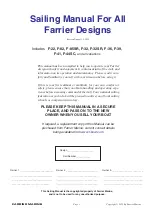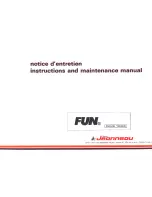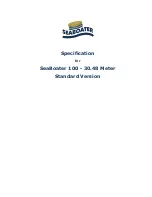
PAGE 10
JIB SHEETS
Jib sheets are a 2:1 endless line, this allows the
flexibility to sheet sitting out on the floats. Attach the
Ronstan 2:1 blocks to the saddle position on main ring
frame and the Ronstan friction rings onto clew of sail.
You are now ready to run the sheet lines. Once the
sheet lines are set you can furl the jib.
The furling line is located on the Starboard side. Once
the luff tension is set and the jib sheets connected you
can now furl the jib by pulling on the line.
When the jib is furled make sure the line is cleated off
(located on side of ring frame).
This will prevent the jib from unfurling prematurely.
MAST SETUP
Rig tension and mast setup are very important for good
sailing performance and while rotating masts do not
require much rig tension (to allow full mast rotation),
most owners do not tension their rigs enough.
Synthetic Rigging used on the cap shrouds will stretch
a little internally but will settle after a few sails. The
wing section masts that are used on Corsair Trimarans
required some pre-bend. The amount of pre-bend is
achieved by tightening the diamond wires.
The Pulse 600 mast has a pre-bend amount of 35mm,
this can be checked by running a messenger line from
the hound area (forestay lug) to the center of boom
shaft along the aft face of mast. 35mm gap will roughly
be around the speader location.
For good windward performance the forestay must be
tight and thus cannot be emphasized too much
An important rule, vital to the well being of all masts,
particularly fixed masts, is to be sure that your leeward
cap shroud never becomes too loose. Some looseness
is not unusual but if it is very loose and visibly flopping
around, you could risk losing your mast. Loose rigging
will also greatly affect the performance of your Corsair.
https://www.boat-manuals.com/










































